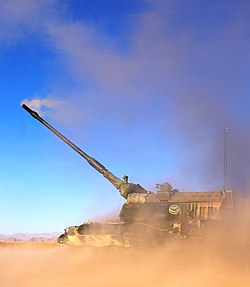
The International Security Assistance Force (ISAF) was a multinational military mission in Afghanistan from 2001 to 2014. It was established by United Nations Security Council Resolution 1386 pursuant to the Bonn Agreement, which outlined the establishment of a permanent Afghan government following the U.S. invasion in October 2001. ISAF's primary goal was to train the Afghan National Security Forces (ANSF) and assist Afghanistan in rebuilding key government institutions; it gradually took part in the broader war in Afghanistan against the Taliban insurgency.

Uruzgan, also spelled as Urozgan or Oruzgan, is one of the thirty-four provinces of Afghanistan. Uruzgan is located in the center of the country. The population is 436,079, and the province is mostly a tribal society. Tarinkot serves as the capital of the province.
Tarīnkōṭ, also spelled as Tarin Kowt, is the capital of Uruzgan Province in southern Afghanistan in the Tarinkot District. Tarinkot city has a population of 71,604 (2015), with some 200 small shops in the city's bazaar.

Multi National Base Tarin Kot is a former International Security Assistance Force (ISAF) installation, used after the Netherlands Armed Forces' departure by the Afghan National Army. The base was located on the outskirts of Tarinkot, the capital of Uruzgan Province in southern Afghanistan.

Task Force Uruzgan (TFU) was Australia's and the Netherlands' contribution to NATO's Regional Command South, International Security Assistance Force, in Afghanistan. The Dutch led one of the four Provincial Reconstruction Teams in the southern region of the country. Mandated by the Dutch Parliament in February 2006, between 1,200 to 1,400 Dutch military were tasked to maintain order in Uruzgan Province through July 2010. They were also to develop political and economic infrastructure and to train the Afghan National Police.

Operation Medusa was a Canadian-led offensive during the second Battle of Panjwaii of the War in Afghanistan. The operation was fought primarily by the 1st Battalion, The Royal Canadian Regiment Battle Group and other elements of the International Security Assistance Force, supported by the Afghan National Army and a team from the United States Army's 1st Battalion, 3rd Special Forces Group (Airborne) augmented by C Company, 2nd Battalion, 87th Infantry Regiment of the 10th Mountain Division. Its goal was to establish government control over an area of Kandahar Province centered in the district of Panjwayi some 30 kilometres (19 mi) west of Kandahar city. A tactical victory, it resulted in the deaths of 12 Canadian soldiers; five during the major combat operations, five in bombings, and two in a mortar/RPG attack during the reconstruction phase of the operation. Fourteen British military personnel were also killed when their plane crashed. Despite suffering a brutal battlefield defeat, the Taliban retained their presence in Kandahar province and did not lose their will to fight, leading to the subsequent Operation Falcon Summit. Nonetheless, Operation Medusa was at the time the most significant land battle ever undertaken by NATO.

Following the terrorist attacks of September 11, 2001, several nations took on Al-Qaeda and the Taliban during Operation Enduring Freedom (OEF) in Afghanistan. OEF was the initial combat operations starting on 7 October 2001, in the wake of the 11 September attacks on the United States, and during 2002 and 2003.

In January 2006, NATO's focus in southern Afghanistan was to form Provincial Reconstruction Teams with the British leading in Helmand Province and the Netherlands, Australia and Canada leading similar deployments in Orūzgān Province and Kandahar Province respectively. The United States, with 2,200 troops, stayed in control of Zabul Province. Local Taliban figures voiced opposition to the incoming force and pledged to resist it.

The following items form a partial timeline of the War in Afghanistan. For events prior to October 7, 2001, see 2001 in Afghanistan.
The following lists events that happened during 2004 in Afghanistan.
The Battle of Musa Qala was a British-led military action in Helmand Province, southern Afghanistan, launched by the Afghan National Army and the International Security Assistance Force (ISAF) against the Taliban on 7 December 2007. After three days of intense fighting, the Taliban retreated into the mountains on 10 December. Musa Qala was officially reported captured on 12 December, with Afghan Army troops pushing into the town centre.

US and NATO International Security Assistance Force (ISAF) operations, alongside Afghan National Army forces, continued against the Taliban through 2007.
Rozi Khan was a Pashtun Barakzai tribal leader in the Afghanistan province of Orūzgān. In the 1980s he was a Mujahideen commander fighting against the Soviets. In 2001 he was appointed police chief of Orūzgān province by President Karzai, a position he held until 2006. He was made governor of Oruzgan's Chora District in mid-2008.
The following lists events that happened during 2006 in Afghanistan.
Ahmad Omaid Khpalwak, also spelled as Ahmed Omed Khpulwak, was an Afghan journalist who worked for the Pajhwok Afghan News and as a freelance stringer for the BBC since 2008. After an investigation into his death, it was determined by the International Security Assistance Force that an American soldier had accidentally killed Khpalwak while clearing a broadcast building of terrorists while Tarin Kowt was under attack. Khpalwak was the third journalist from Pajhwok to be killed in three years. He was the third BBC reporter to be killed in Afghanistan and the second BBC reporter to be killed in the War in Afghanistan.

Events from the year 2012 in Afghanistan.
The following lists events that happened in 2013 in Afghanistan.
The following lists events that happened during 2016 in Afghanistan.
Chora is a town and the capital of Chora District in Uruzgan Province in southern Afghanistan. Chora has a population of about 3,000. It is a rural town with no industry beyond livestock, agriculture, and small merchants.










